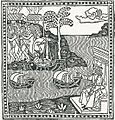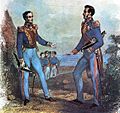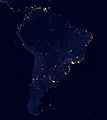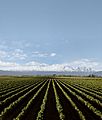South America facts for kids
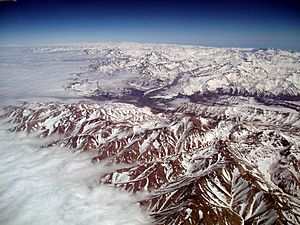
South America is a large continent located south of North America. These two continents are separated by the Panama Canal. South America connects to Central America near the border of Panama. Even though some of Panama is east of the Panama Canal, it's usually considered part of North America.
South America stretches from the warm Caribbean Sea almost all the way to Antarctica. It has the Atlantic Ocean on its east side and the Pacific Ocean on its west side. The continent can be thought of in four main parts:
- The Caribbean Republics: These include Colombia, Venezuela, Guyana, Suriname, and French Guiana.
- The Andean Republics: These countries are Bolivia, Ecuador, Chile, Colombia, and Peru. They are named after the Andes mountains.
- The River Plate Republics: This group includes Uruguay, Paraguay, and Argentina.
- Brazil: This is the largest country in South America, covering almost half of the entire continent!
Contents
What is the Climate Like in South America?
Most of South America has a tropical climate, meaning it's generally warm all year. In the north, it's often humid and tropical, or like a tropical savanna (grasslands with scattered trees). The southeast has a humid subtropical climate.
Rainfall varies a lot across the continent. The Atacama Desert in Chile is one of the driest places on Earth, getting very little rain. On the other hand, the Amazon basin is incredibly rainy, with an average of 2,000 millimeters (about 79 inches) of rain each year. The Brazilian plateau usually gets between 1,000 and 2,000 millimeters of rain.
Temperatures also differ greatly. In the high mountains, the average temperature is around 15 degrees Celsius (59 degrees Fahrenheit). But in the tropical areas, temperatures can easily go above 38 degrees Celsius (100 degrees Fahrenheit)!
What Natural Resources Does South America Have?
South America is rich in natural resources. The soil in Argentina's Pampas region is some of the best in the world for farming. Brazil's soil is excellent for growing coffee.
Many minerals have been found across the continent. Some of the most important ones that have been mined include iron, manganese, gold, and beautiful gemstones. The tropical forests are full of valuable trees like mahogany, ebony, and rubber. Oil is also an important resource in some areas.
What Animals Live in South America?
South America is home to a huge variety of amazing animals! You can find creatures like powerful jaguars, colorful macaws, playful monkeys, giant anacondas, and unique llamas. The rivers are home to piranhas, while the skies have bright toucans and huge condors. Other interesting animals include tapirs, cougars, and tiny chinchillas.
What are the Most Popular Tourist Attractions?
South America has many incredible places that people love to visit:
- Machu Picchu: This is an ancient historic site in Peru, built by the Inca people.
- The Iguazu Falls: These are massive waterfalls located on the border between Argentina and Brazil.
- The Angel Falls: Found in Venezuela, this is the world's tallest waterfall!
- Rio de Janeiro and its carnival: This vibrant city in Brazil is famous for its beautiful beaches and lively annual carnival celebration.
- The Patagonia region: This stunning area of mountains, glaciers, and grasslands is shared by Argentina and Chile.
- The Christ Redeemer: A famous large statue of Jesus Christ overlooking Rio de Janeiro, Brazil.
Images for kids
-
Los Roques Archipelago, Venezuela
-
The prehistoric Cueva de las Manos, or "Cave of the Hands", in Argentina
-
The Inca estate of Machu Picchu, Peru is one of the New Seven Wonders of the World.
-
Woodcut depicting Italian explorer Amerigo Vespucci's first voyage (1497–98) to the New World, from the first known published edition of Vespucci's 1504 letter to Piero Soderini.
-
The Portuguese explorer Pedro Álvares Cabral landing in Brazil in 1500
-
Dutch colonial houses in Paramaribo, Suriname
-
A painting of the settlement of Pernambuco in colonial Brazil by Frans Post
-
The proclamation of the Independence of Brazil by Prince Pedro on 7 September 1822
-
The Guayaquil conference between José de San Martín and Simón Bolívar
-
Coronation of Pedro I as 1st Emperor of Brazil
-
Bernardo O'Higgins swears officially the independence of Chile.
-
The Thirty-Three Orientals proclaimed the independence of Cisplatine Province.
-
Imperial Brazilian Navy and army troops during the Siege of Paysandú, 1865
-
The Uruguayan Army at the Battle of Sauce, 1866
-
The Imperial Brazilian Army during a procession in Paraguay, 1868
-
Argentine soldiers during the Falklands War
-
Presidents of UNASUR member states at the Second Brasília Summit on 23 May 2008.
-
Satellite view of South America at night from NASA, showing the contrast between heavily populated coastal areas and the more remote regions of the Amazonian interior and Patagonia.
-
Peruvian woman and her son
-
Rafael Correa, Evo Morales, Néstor Kirchner, Cristina Fernández, Luiz Inácio Lula da Silva, Nicanor Duarte, and Hugo Chávez signed the founding charter of the Bank of the South.
-
Trading panel of the São Paulo Stock Exchange is the second biggest in the Americas and 13th in the world.
-
Launch at the Kourou Space Centre in French Guiana
-
Refinery of Brazilian state-owned Petrobras in Cochabamba, Bolivia
-
Chuquicamata is the largest open pit mine in the world, near the city of Calama in Chile.
-
KC-390 is the largest military transport aircraft produced in South America by the Brazilian company Embraer.
-
Vineyard in Luján de Cuyo, province of Mendoza, Argentina
-
Sugarcane plantation in São Paulo. In 2018, Brazil was the world's largest producer, with 746 million tonnes. South America produces half of the world's sugarcane.
-
Soy plantation in Mato Grosso. In 2020, Brazil was the world's largest producer, with 130 million tonnes. South America produces half of the world's soybeans.
-
Coffee in Minas Gerais. In 2018, Brazil was the world's largest producer, with 3.5 million tonnes. South America produces half of the world's coffee.
-
Orange in São Paulo. In 2018, Brazil was the world's largest producer, with 17 million tonnes. South America produces 25% of the world's orange.
-
Cerro Rico, Potosi, Bolivia, still a major silver mine
-
Iron mine in Minas Gerais. Brazil is the world's second largest iron ore exporter.
-
Bird (UOB Plaza, Singapore), sculpture of Colombian artist Fernando Botero
-
"Chromovegetal Maze" by Carlos Cruz Diez, in Caracas.
-
Maracanã Stadium in Rio de Janeiro, Brazil
-
Panorama of the interior of the Maracanã stadium during the closing ceremony of the 2014 FIFA World Cup
-
Wind power in Parnaíba.
-
Angra Nuclear Power Plant in Angra dos Reis, Rio de Janeiro
-
General Rafael Urdaneta Bridge in Venezuela
-
Maize in Dourados. Brazil and Argentina are among the 5 largest world producers
-
Mercedes-Benz plant in São Paulo. Brazil is among the 10 largest vehicle manufacturers in the world and Argentina among the 30 largest.
-
Honey production in Argentina. The country is the third largest producer of honey in the world.
-
Sunflower plantation in Argentina. The country is the world's third largest producer of sunflower seed.
-
Palm plantation in Magdalena. Colombia is one of the top 5 palm oil producers in the world.
See also
 In Spanish: América del Sur para niños
In Spanish: América del Sur para niños









